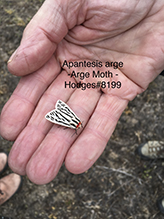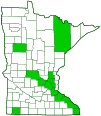arge moth
(Apantesis arge)
Conservation • Description • Habitat • Ecology • Distribution • Taxonomy
|
||||||||
| Hodges # | 8199 |
|||||||
Conservation Status |
||||||||
| IUCN Red List | not listed |
|||||||
| NatureServe | NNR - Unranked |
|||||||
| Minnesota | not listed |
|||||||
Description |
||
Arge moth is a common, medium-sized, tiger moth. It occurs in North America from southern Quebec to northern Florida, west to South Dakota and New Mexico. It is most common in northeast and south-central United States, less common in Minnesota. Larva feed on the leaves of many low-growing plants and vines, including corn, dock, goosefoot, grape, plantain, prickly pear, smartweed, and sunflower. Adults are found in from April to September in dry open areas, including dry woodlands, dunes, grasslands, meadows, pastures, sand plains, and waste lots. They do not feed. Adults are robust, hairy, and creamy-white and black, sometimes tinged with pink. They are ¾″ to 1″ (20 to 26 mm) in length and have a 1½″ to 2″ (38 to 50 mm) wingspan. The thorax is densely covered with long, creamy white hairs, sometimes partially tinged pinkish. It has three black longitudinal stripes and a dark pink collar. The abdomen is mostly white, tinged pink on top (dorsally), with two rows of black spots on each side. The head is white. The antennae are black. On the male they are feathery, with extensions along both sides of the shaft (bipectinate). The antennae on the female are slender and thread-like. The mouthparts are not functional. The male forewing length is 11⁄16″ (18.3 mm). The forewing is mostly white. The background color is black. The veins and bands are white. The leading edge (costal margin), inner margin, and outer margin all have a broad white band on the border. Most veins are broadly bordered with white. The anal vein (A1+2) is white but is not bordered, and it merges with the band on the inner margin. The postmedial (PM) band is sharply bent, touches the subterminal (ST) band, and meets the costal margin at an oblique angle. The ST band is W-shaped. The fringe is white. The costal cell (C1) is white, being overlayed by the broad costal border. This feature distinguishes arge moth from all other Apantesis moths except Apantesis doris, which does not occur in Minnesota. The hindwing is white and is shaded with pink. It has just a few small black spots. The larger spots, if any, are divided by white or pink lines. The female is similar but has a forewing length of 15⁄16″ (23.8 mm). The caterpillar is purple to charcoal black and 1¾″ (45 mm) long. There are prominent white stripes in the middorsal and subdorsal areas. These white stripes often have areas tinged with orange. The body is covered with clusters of long hairs (setae). Each cluster rises from a black wart. Each lateral wart has at least one very long seta. |
||
Size |
||
Total length: ¾″ to 1″ (20 to 26 mm) Wingspan: 1½″ to 2″ (38 to 50 mm) |
||
Similar Species |
||
Habitat |
||
Dry open areas, including dry woodlands, dunes, grasslands, meadows, pastures, sand plains, and waste lots |
||
Ecology |
||
Season |
||
Two generations per year: April to September |
||
Behavior |
||
Adults will come to black light. The wings are held over the body like a roof when at rest. |
||
Life Cycle |
||
|
||
Larva Hosts |
||
Many low-growing plants and vines, including corn, dock, goosefoot, grape, plantain, prickly pear, smartweed, and sunflower |
||
Adult Food |
||
Adults do not feed. |
||
Distribution |
||||
|
Sources |
|||
| 12/1/2021 | ||||
Occurrence |
||||
Common |
||||
Taxonomy |
|||
Order |
Lepidoptera (Butterflies and Moths) | ||
Superfamily |
Noctuoidea (owlet moths and allies) | ||
Family |
Erebidae (underwing, tiger, tussock, and allied moths) | ||
Subfamily |
Arctiinae (tiger moths and allies) | ||
Tribe |
Arctiini (tiger moths) | ||
| Subtribe | Arctiina | ||
Genus |
Apantesis | ||
Family Genus |
|||
Synonyms |
|||
Apantesis nervosa Arctia strigosa Bombyx dione Grammia arge Noctua incarnatorubra Phalaena arge |
|||
Common Names |
|||
arge moth |
|||
Glossary
Costal margin
The leading edge of the forewing of insects.
Postmedial (PM) line
A thin line separating the median area and the postmedial area of the forewing of Lepidoptera.
Seta
A stiff, hair-like process on the outer surface of an organism. In Lepidoptera: A usually rigid bristle- or hair-like outgrowth used to sense touch. In mosses: The stalk supporting a spore-bearing capsule and supplying it with nutrients. Plural: setae. Adjective: setose.
Visitor Photos |
|||||
Share your photo of this insect. |
|||||
| This button not working for you? Simply email us at info@MinnesotaSeasons.com. Attach one or more photos and, if you like, a caption. |
|||||
Nancy Falkum |
|||||
 |
|||||
MinnesotaSeasons.com Photos |
|||||
|
|||||

Slideshows |
||

Visitor Videos |
|||
Share your video of this insect. |
|||
| This button not working for you? Simply email us at info@MinnesotaSeasons.com. Attach a video, a YouTube link, or a cloud storage link. |
|||
Other Videos |
|||

Created: 12/1/2021
Last Updated:


